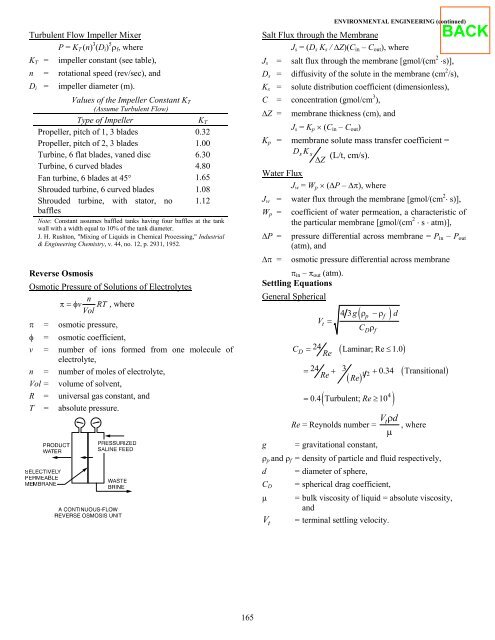fundamentals of engineering supplied-reference handbook - Ventech!
fundamentals of engineering supplied-reference handbook - Ventech!
fundamentals of engineering supplied-reference handbook - Ventech!
Create successful ePaper yourself
Turn your PDF publications into a flip-book with our unique Google optimized e-Paper software.
Turbulent Flow Impeller Mixer<br />
P = KT (n) 3 (Di) 5 ρf, where<br />
KT = impeller constant (see table),<br />
n = rotational speed (rev/sec), and<br />
Di = impeller diameter (m).<br />
Values <strong>of</strong> the Impeller Constant KT<br />
(Assume Turbulent Flow)<br />
Type <strong>of</strong> Impeller KT<br />
Propeller, pitch <strong>of</strong> 1, 3 blades 0.32<br />
Propeller, pitch <strong>of</strong> 2, 3 blades 1.00<br />
Turbine, 6 flat blades, vaned disc 6.30<br />
Turbine, 6 curved blades 4.80<br />
Fan turbine, 6 blades at 45° 1.65<br />
Shrouded turbine, 6 curved blades 1.08<br />
Shrouded turbine, with stator, no<br />
baffles<br />
1.12<br />
Note: Constant assumes baffled tanks having four baffles at the tank<br />
wall with a width equal to 10% <strong>of</strong> the tank diameter.<br />
J. H. Rushton, "Mixing <strong>of</strong> Liquids in Chemical Processing," Industrial<br />
& Engineering Chemistry, v. 44, no. 12, p. 2931, 1952.<br />
Reverse Osmosis<br />
Osmotic Pressure <strong>of</strong> Solutions <strong>of</strong> Electrolytes<br />
n<br />
π=φ v RT , where<br />
Vol<br />
π = osmotic pressure,<br />
φ = osmotic coefficient,<br />
v = number <strong>of</strong> ions formed from one molecule <strong>of</strong><br />
electrolyte,<br />
n = number <strong>of</strong> moles <strong>of</strong> electrolyte,<br />
Vol = volume <strong>of</strong> solvent,<br />
R = universal gas constant, and<br />
T = absolute pressure.<br />
165<br />
Salt Flux through the Membrane<br />
ENVIRONMENTAL ENGINEERING (continued)<br />
Js =<br />
Js = (Ds Ks / ∆Z)(Cin – Cout), where<br />
salt flux through the membrane [gmol/(cm 2 ⋅s)],<br />
Ds = diffusivity <strong>of</strong> the solute in the membrane (cm 2 /s),<br />
Ks = solute distribution coefficient (dimensionless),<br />
C = concentration (gmol/cm 3 ),<br />
∆Z = membrane thickness (cm), and<br />
Js = Kp × (Cin – Cout)<br />
Kp = membrane solute mass transfer coefficient =<br />
Ds K s (L/t, cm/s).<br />
∆ Z<br />
Water Flux<br />
Jw = Wp × (∆P – ∆π), where<br />
Jw = water flux through the membrane [gmol/(cm 2 ⋅ s)],<br />
Wp = coefficient <strong>of</strong> water permeation, a characteristic <strong>of</strong><br />
the particular membrane [gmol/(cm 2 ⋅ s ⋅ atm)],<br />
∆P = pressure differential across membrane = Pin – Pout<br />
(atm), and<br />
∆π = osmotic pressure differential across membrane<br />
πin – πout (atm).<br />
Settling Equations<br />
General Spherical<br />
C<br />
D<br />
V<br />
t<br />
=<br />
( ρp −ρf<br />
)<br />
43g<br />
d<br />
C ρ<br />
( )<br />
= 24<br />
Re<br />
Laminar; Re ≤1.0<br />
( )<br />
D f<br />
4<br />
( Re )<br />
( )<br />
= 24 3<br />
Re<br />
+ 12+<br />
0.34 Transitional<br />
Re<br />
= 0.4 Turbulent; ≥10<br />
Re = Reynolds number = ρ Vtd , where<br />
µ<br />
g = gravitational constant,<br />
ρp and ρf = density <strong>of</strong> particle and fluid respectively,<br />
d = diameter <strong>of</strong> sphere,<br />
CD<br />
= spherical drag coefficient,<br />
µ = bulk viscosity <strong>of</strong> liquid = absolute viscosity,<br />
and<br />
V t = terminal settling velocity.
















